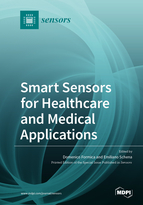Smart Sensors for Healthcare and Medical Applications
A special issue of Sensors (ISSN 1424-8220). This special issue belongs to the section "Physical Sensors".
Deadline for manuscript submissions: closed (15 September 2020) | Viewed by 123989
Special Issue Editors
Interests: robotics; mechatronic; human motor control; neuroengineering; human-machine interaction
Special Issues, Collections and Topics in MDPI journals
Interests: physiological monitoring; wearable systems; wearable sensors; physiological measurements; active living; cardiorespiratory monitoring; soft sensors
Special Issues, Collections and Topics in MDPI journals
Special Issue Information
Dear Colleagues,
Recent advances in mechatronic technologies, the Internet of Things, wearable systems, miniaturized sensors, and data analysis are revolutionizing the way personal care services are provided, from the screening and prevention of pathologies to the management of chronic diseases. In this context, smart sensors play a crucial role in monitoring the progression of the pathologies, assessing the efficacy of administered therapies, providing rapid, low-cost and non-invasive diagnoses, as well as monitoring online relevant or vital signals during medical procedures.
This Special Issue is focused on new smart sensors and their applications to improve the effectiveness, efficiency, safety and sustainability of healthcare services in acute and chronic conditions, but also for prevention towards a healthy life and active aging. We strongly encourage the submission of papers focussing on the keywords below, but works on related topics will also be considered.
Prof. Domenico Formica
Prof. Emiliano Schena
Guest Editors
Manuscript Submission Information
Manuscripts should be submitted online at www.mdpi.com by registering and logging in to this website. Once you are registered, click here to go to the submission form. Manuscripts can be submitted until the deadline. All submissions that pass pre-check are peer-reviewed. Accepted papers will be published continuously in the journal (as soon as accepted) and will be listed together on the special issue website. Research articles, review articles as well as short communications are invited. For planned papers, a title and short abstract (about 100 words) can be sent to the Editorial Office for announcement on this website.
Submitted manuscripts should not have been published previously, nor be under consideration for publication elsewhere (except conference proceedings papers). All manuscripts are thoroughly refereed through a single-blind peer-review process. A guide for authors and other relevant information for submission of manuscripts is available on the Instructions for Authors page. Sensors is an international peer-reviewed open access semimonthly journal published by MDPI.
Please visit the Instructions for Authors page before submitting a manuscript. The Article Processing Charge (APC) for publication in this open access journal is 2600 CHF (Swiss Francs). Submitted papers should be well formatted and use good English. Authors may use MDPI's English editing service prior to publication or during author revisions.
Keywords
- Wearable motion sensors for medical applications
- Wearable sensors for monitoring physiological parameters
- Implantable sensors for healthcare
- Environmental sensors for healthcare applications
- Sensors for monitoring surgical procedures
- Sensors for physical rehabilitation
- Sensors for neuroscience
- Sensors for telemedicine
- Body area sensor networks for medical applications
- Sensors for continuous patient monitoring
- Sensors for at home assessment of patients
- Metrological assessment of smart sensors








